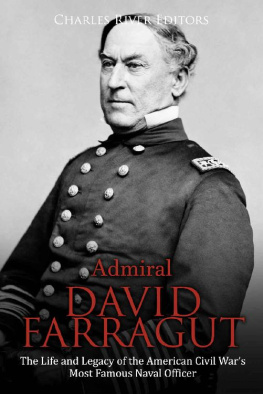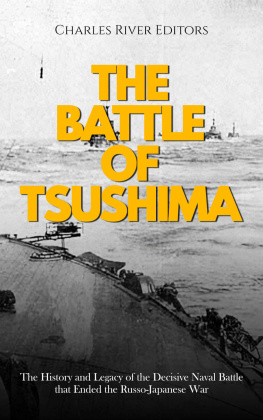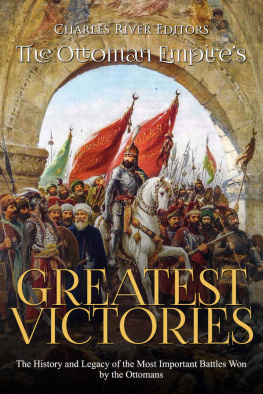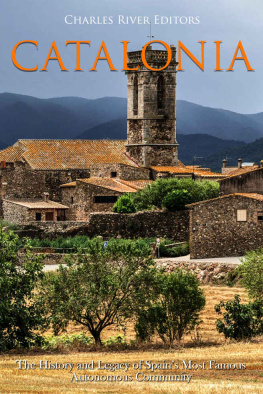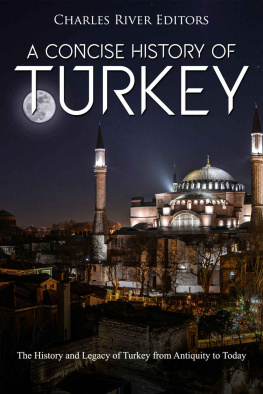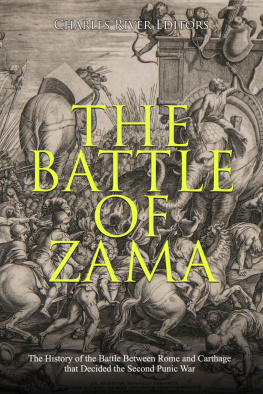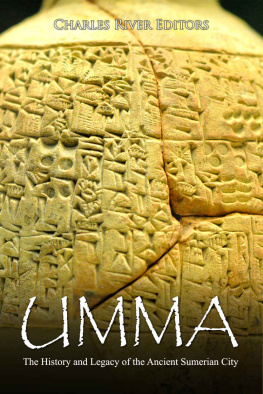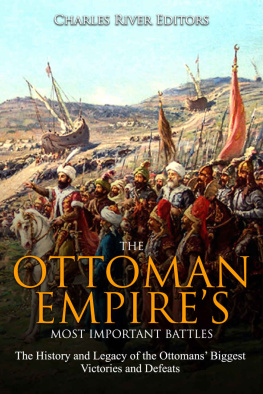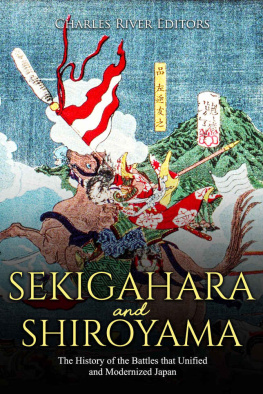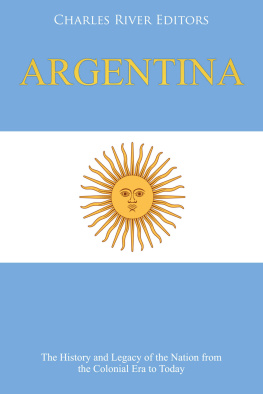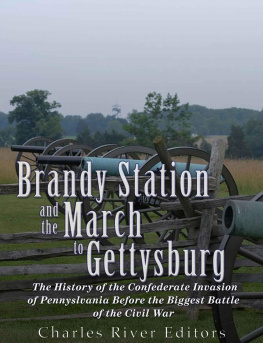Charles River Editors - The Battle of Cannae and the Battle of Zama: The History and Legacy of the Second Punic War’s Most Important Battles
Here you can read online Charles River Editors - The Battle of Cannae and the Battle of Zama: The History and Legacy of the Second Punic War’s Most Important Battles full text of the book (entire story) in english for free. Download pdf and epub, get meaning, cover and reviews about this ebook. year: 2020, publisher: Charles River Editors, genre: History. Description of the work, (preface) as well as reviews are available. Best literature library LitArk.com created for fans of good reading and offers a wide selection of genres:
Romance novel
Science fiction
Adventure
Detective
Science
History
Home and family
Prose
Art
Politics
Computer
Non-fiction
Religion
Business
Children
Humor
Choose a favorite category and find really read worthwhile books. Enjoy immersion in the world of imagination, feel the emotions of the characters or learn something new for yourself, make an fascinating discovery.

- Book:The Battle of Cannae and the Battle of Zama: The History and Legacy of the Second Punic War’s Most Important Battles
- Author:
- Publisher:Charles River Editors
- Genre:
- Year:2020
- Rating:5 / 5
- Favourites:Add to favourites
- Your mark:
- 100
- 1
- 2
- 3
- 4
- 5
The Battle of Cannae and the Battle of Zama: The History and Legacy of the Second Punic War’s Most Important Battles: summary, description and annotation
We offer to read an annotation, description, summary or preface (depends on what the author of the book "The Battle of Cannae and the Battle of Zama: The History and Legacy of the Second Punic War’s Most Important Battles" wrote himself). If you haven't found the necessary information about the book — write in the comments, we will try to find it.
The Battle of Cannae and the Battle of Zama: The History and Legacy of the Second Punic War’s Most Important Battles — read online for free the complete book (whole text) full work
Below is the text of the book, divided by pages. System saving the place of the last page read, allows you to conveniently read the book "The Battle of Cannae and the Battle of Zama: The History and Legacy of the Second Punic War’s Most Important Battles" online for free, without having to search again every time where you left off. Put a bookmark, and you can go to the page where you finished reading at any time.
Font size:
Interval:
Bookmark:
By Charles River Editors

A depiction of Hannibal crossing the Alps during the Second Punic War

Charles River Editors provides superior editing and original writing services across the digital publishing industry, with the expertise to create digital content for publishers across a vast range of subject matter. In addition to providing original digital content for third party publishers, we also republish civilizations greatest literary works, bringing them to new generations of readers via ebooks.
Sign up here to receive updates about free books as we publish them , and visit Our Kindle Author Page to browse todays free promotions and our most recently published Kindle titles.

Jorg Schulzs picture of a modern monument near the battlefield of Cannae
Few battles of ancient times are more marked by ability...than the battle of Cannae. The position was such as to place every advantage on Hannibal's side. The manner in which the far from perfect Hispanic and Gallic foot was advanced in a wedge in chelon...was first held there and then withdrawn step by step, until it had reached the converse position...is a simple masterpiece of battle tactics. The advance at the proper moment of the African infantry, and its wheel right and left upon the flanks of the disordered and crowded Roman legionaries, is far beyond praise. The whole battle, from the Carthaginian standpoint, is a consummate piece of art, having no superior, few equal, examples in the history of war. Theodore Dodge, military historian
Carthage was one of the great ancient civilizations, and at its peak, the wealthy Carthaginian empire dominated the Mediterranean against the likes of Greece and Rome, with commercial enterprises and influence stretching from Spain to Turkey. In fact, at several points in history it had a very real chance of replacing the fledgling Roman empire or the failing Greek poleis (city-states) altogether as master of the Mediterranean. Although Carthage by far preferred to exert economic pressure and influence before resorting to direct military power (and even went so far as to rely primarily on mercenary armies paid with its vast wealth for much of its history, it nonetheless produced a number of outstanding generals, from the likes of Hanno Magnus to, of course, the great bogeyman of Roman nightmares himself: Hannibal.
However, the Carthaginians foreign policy had one fatal flaw; they had a knack over the centuries of picking the worst enemies they could possibly enter into conflict with. The first serious clash of civilizations which Carthage was involved with was Greece, which rapidly became hostile when the Carthaginians began pushing to spread their influence towards the colonies known as Magna Graecia (Great Greece), which had been established in southern Italy and Sicily by several Greek poleis . These territories would become a casus belli of the First Punic War.
Certain foreign policy decisions led to continuing enmity between Carthage and the burgeoning power of Rome, and what followed was a series of wars which turned from a battle for Mediterranean hegemony into an all-out struggle for survival. Although the Romans gained the upper hand in the wake of the First Punic War, Hannibal brought the Romans to their knees for over a decade during the Second Punic War. While military historians are still amazed that he was able to maintain his army in Italy near Rome for nearly 15 years, scholars are still puzzled over some of his decisions, including why he never attempted to march on Rome in the first place.
Regardless, Hannibal was such a threat that the Romans responded in an unprecedented nature when the Carthaginians resumed the campaigning season in the spring of 216 BCE by capturing the city of Cannae, a crucial supply hub, and placing themselves along the line that convoys from the ports and warehouses of the south needed to travel to reach Rome. This was something the Romans could not and did not take lying down; Rome raised the largest army in their citys history, a force of between 80,000 and 100,000 men, and marched south with Consuls Varro and Paullus at the head of the army. This military behemoth disregarded the delaying tactics that Maximus had favored, fully determined to destroy Hannibal once and for all as quickly as possible. Polybius described the incredible size of this Roman army: The Senate determined to bring eight legions into the field, which had never been done at Rome before, each legion consisting of five thousand men besides allies....Most of their wars are decided by one consul and two legions, with their quota of allies; and they rarely employ all four at one time and on one service. But on this occasion, so great was the alarm and terror of what would happen, they resolved to bring not only four but eight legions into the field.
Despite the massive horde headed his way, Hannibal was ready for them. He encamped his army near the Aufidus, a river not far from Cannae, and waited. His intelligence told him that Consul Varro, the more influential of the two Roman generals, was a firebrand, talented in attack but with a tendency to overreach himself, and Hannibal resolved to use this flaw to his advantage. Hannibal arrayed his army in the open, sure that Varro would be unable to resist the temptation to offer battle, and then deliberately placed his weakest infantry in the center of his battle-line. Varro led the Roman legions straight at the centre of Hannibals formation, proceeding in characteristic bull-headed fashion and spearheading the assault himself. Hannibals troops in the center yielded before the legions, as Hannibal had anticipated, sucking the bulk of the Roman force deep into the centre of Hannibals formation. Meanwhile, the wings of Hannibals infantry automatically swung against the flanks of the Roman force while Hannibals cavalry, led by his celebrated general Maharbal, crushed the Roman cavalry and light infantry deployed to protect the formations flanks and rear and, in so doing, succeeded in encircling it completely. The Roman force now found itself unable to run or maneuver, completely surrounded by Hannibals forces. It was one of the earliest examples of the pincer movement in the history of warfare.
The result was a massacre, one of the most vicious battles in the history of the world. Around 75% of the Roman army was cut down in the ensuing melee, which would be in the vicinity of between 50,000-80,000 soldiers depending on which initial estimates are considered to be accurate. Among the casualties was the luckless Consul Paullus, two-thirds of the citys Military Tribunes, a host of officials and noblemen from the most prominent Roman families, and almost a full third of the Senate. Hannibals army killed so many prominent Romans that his men collected more than 200 gold signets from dead Romans, and he had the rings sent to Carthage to demonstrate his complete victory.
Livy described the scene, "So many thousands of Romans were dying ... Some, whom their wounds, pinched by the morning cold, had roused, as they were rising up, covered with blood, from the midst of the heaps of slain, were overpowered by the enemy. Some were found with their heads plunged into the earth, which they had excavated; having thus, as it appeared, made pits for themselves, and having suffocated themselves." If the casualty numbers are accurate, Hannibals army slaughtered an average of 600 Roman soldiers every minute until nightfall ended the battle, and less than 15,000 Roman troops escaped, which required cutting their way through the center of Hannibals army and fleeing to the nearby town of Canusium.
Font size:
Interval:
Bookmark:
Similar books «The Battle of Cannae and the Battle of Zama: The History and Legacy of the Second Punic War’s Most Important Battles»
Look at similar books to The Battle of Cannae and the Battle of Zama: The History and Legacy of the Second Punic War’s Most Important Battles. We have selected literature similar in name and meaning in the hope of providing readers with more options to find new, interesting, not yet read works.
Discussion, reviews of the book The Battle of Cannae and the Battle of Zama: The History and Legacy of the Second Punic War’s Most Important Battles and just readers' own opinions. Leave your comments, write what you think about the work, its meaning or the main characters. Specify what exactly you liked and what you didn't like, and why you think so.






